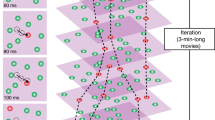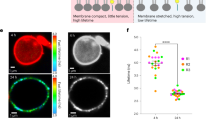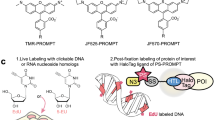Abstract
DNA-binding proteins (DNA-BPs) and RNA-binding proteins (RNA-BPs) have critical roles in living cells in all kingdoms of life. Various experimental approaches exist for the study of nucleic acid–protein interactions in vitro and in vivo, but the detection of such interactions at the subcellular level remains challenging. Here we describe how to detect nucleic acid–protein interactions in plant leaves by using a fluorescence resonance energy transfer (FRET) approach coupled to fluorescence lifetime imaging microscopy (FLIM). Proteins of interest (POI) are tagged with a GFP and transiently expressed in plant cells to serve as donor fluorophore. After sample fixation and cell wall permeabilization, leaves are treated with Sytox Orange, a nucleic acid dye that can function as a FRET acceptor. Upon close association of the GFP-tagged POI with Sytox-Orange-stained nucleic acids, a substantial decrease of the GFP lifetime due to FRET between the donor and the acceptor can be monitored. Treatment with RNase before FRET–FLIM measurements allows determination of whether the POI associates with DNA and/or RNA. A step-by-step protocol is provided for sample preparation, data acquisition and analysis. We describe how to calibrate the equipment and include a tutorial explaining the use of the FLIM software. To illustrate our approach, we provide experimental procedures to detect the interaction between plant DNA and two proteins (the AeCRN13 effector from the oomycete Aphanomyces euteiches and the AtWRKY22 defensive transcription factor from Arabidopsis). This protocol allows the detection of protein–nucleic acid interactions in plant cells and can be completed in <2 d.
This is a preview of subscription content, access via your institution
Access options
Access Nature and 54 other Nature Portfolio journals
Get Nature+, our best-value online-access subscription
$29.99 / 30 days
cancel any time
Subscribe to this journal
Receive 12 print issues and online access
$259.00 per year
only $21.58 per issue
Buy this article
- Purchase on Springer Link
- Instant access to full article PDF
Prices may be subject to local taxes which are calculated during checkout










Similar content being viewed by others
References
Luscombe, N.M., Austin, S.E., Berman, H.M. & Thornton, J.M. An overview of the structures of protein-DNA complexes. Genome Biol. 1, reviews001.1 (2000).
Motion, G.B., Howden, A.J.M., Huitema, E. & Jones, S. DNA-binding protein prediction using plant specific support vector machines: validation and application of a new genome annotation tool. Nucleic Acids Res. 43, e158–e158 (2015).
Hudson, W.H. & Ortlund, E.A. The structure, function and evolution of proteins that bind DNA and RNA. Nat. Rev. Mol. Cell Biol. 15, 749–760 (2014).
Hung, T. et al. Extensive and coordinated transcription of noncoding RNAs within cell-cycle promoters. Nat. Genet. 43, 621–629 (2011).
Huarte, M. et al. A large intergenic noncoding RNA induced by p53 mediates global gene repression in the p53 response. Cell 142, 409–419 (2010).
Martianov, I., Ramadass, A., Serra Barros, A., Chow, N. & Akoulitchev, A. Repression of the human dihydrofolate reductase gene by a non-coding interfering transcript. Nature 445, 666–670 (2007).
Wang, X. et al. Induced ncRNAs allosterically modify RNA-binding proteins in cis to inhibit transcription. Nature 454, 126–130 (2008).
Murphy, F.V. & Churchill, M.E. Nonsequence-specific DNA recognition: a structural perspective. Structure 8, R83–R89 (2000).
Jankowsky, E. & Harris, M.E. Specificity and nonspecificity in RNA-protein interactions. Nat. Rev. Mol. Cell Biol. 16, 533–544 (2015).
Young, C.L., Khoshnevis, S. & Karbstein, K. Cofactor-dependent specificity of a DEAD-box protein. Proc. Natl. Acad. Sci. USA 110, E2668–E2676 (2013).
Siggers, T., Duyzend, M.H., Reddy, J., Khan, S. & Bulyk, M.L. Non-DNA-binding cofactors enhance DNA-binding specificity of a transcriptional regulatory complex. Mol. Syst. Biol. 7, 555 (2014).
Fried, M. & Crothers, D.M. Equilibria and kinetics of lac repressor-operator interactions by polyacrylamide gel electrophoresis. Nucleic Acids Res. 9, 6505–6525 (1981).
Hellman, L.M. & Fried, M.G. Electrophoretic mobility shift assay (EMSA) for detecting protein–nucleic acid interactions. Nat. Protoc. 2, 1849–1861 (2007).
Electrophoretic mobility shift assays. Nat. Methods 2, 557–558 (2005).
Cavaillès, V., Dauvois, S., Danielian, P.S. & Parker, M.G. Interaction of proteins with transcriptionally active estrogen receptors. Proc. Natl. Acad. Sci. USA 91, 10009–10013 (1994).
Wu, K.K. in Gene Mapping, Discovery, and Expression 338, 281–290, (Humana Press, 2006).
Deng, W.-G., Zhu, Y., Montero, A. & Wu, K.K. Quantitative analysis of binding of transcription factor complex to biotinylated DNA probe by a streptavidin-agarose pulldown assay. Anal. Biochem. 323, 12–18 (2003).
Galas, D.J. & Schmitz, A. DNAse footprinting: a simple method for the detection of protein-DNA binding specificity. Nucleic Acids Res. 5, 3157–3170 (1978).
Hampshire, A., Rusling, D., Broughtonhead, V. & Fox, K. Footprinting: a method for determining the sequence selectivity, affinity and kinetics of DNA-binding ligands. Methods 42, 128–140 (2007).
Ahmed, F.E., Wiley, J.E., Weidner, D.A., Bonnerup, C. & Mota, H. Surface plasmon resonance (SPR) spectrometry as a tool to analyze nucleic acid-protein interactions in crude cellular extracts. Cancer Genomics Proteomics 7, 303–309 (2010).
Flores, J.K. et al. Biophysical characterisation and quantification of nucleic acid-protein interactions: EMSA, MST and SPR. Curr. Protein Pept. Sci. 16, 727–734 (2015).
Reece-Hoyes, J.S. & Marian Walhout, A.J. Yeast one-hybrid assays: a historical and technical perspective. Methods 57, 441–447 (2012).
Ouwerkerk, P.B.F. & Meijer, A.H. in Current Protocols in Molecular Biology Chapter 12, Unit 12.12 (Wiley, 2001).
Gilmour, D.S. & Lis, J.T. Detecting protein-DNA interactions in vivo: distribution of RNA polymerase on specific bacterial genes. Proc. Natl. Acad. Sci. USA 81, 4275–4279 (1984).
Gilmour, D.S. & Lis, J.T. In vivo interactions of RNA polymerase II with genes of Drosophila melanogaster. Mol. Cell Biol. 5, 2009–2018 (1985).
Yamaguchi, N. et al. PROTOCOLS: chromatin immunoprecipitation from Arabidopsis tissues. Arabidopsis Book 12, e0170 (2014).
Wu, J., Smith, L.T., Plass, C. & Huang, T.H.-M. ChIP-chip comes of age for genome-wide functional analysis. Cancer Res. 66, 6899–69002 (2006).
Mardis, E.R. ChIP-seq: welcome to the new frontier. Nat. Methods 4, 613–614 (2007).
Marchese, D., de Groot, N.S., Lorenzo Gotor, N., Livi, C.M. & Tartaglia, G.G. Advances in the characterization of RNA-binding proteins. Wiley Interdiscip. Rev. RNA 7, 793–810 (2016).
Gagnon, K.T. & Maxwell, E.S. Electrophoretic mobility shift assay for characterizing RNA-protein interaction. Methods Mol. Biol. 703, 275–291 (2011).
Barnes, C. & Kanhere, A. Identification of RNA-protein interactions through in vitro RNA pull-down assays. Methods Mol. Biol. 1480, 99–113 (2016).
Silverman, I.M. et al. RNase-mediated protein footprint sequencing reveals protein-binding sites throughout the human transcriptome. Genome Biol. 15, R3 (2014).
Gilbert, C. & Svejstrup, J.Q. RNA immunoprecipitation for determining RNA-protein associations in vivo. Curr. Protoc. Mol. Biol. Chapter 27, Unit 27.4 (2006).
Licatalosi, D.D. & Darnell, R.B. RNA processing and its regulation: global insights into biological networks. Nat. Rev. Genet. 11, 75–87 (2010).
Cremazy, F.G.E. et al. Imaging in situ protein-DNA interactions in the cell nucleus using FRET-FLIM. Exp. Cell Res. 309, 390–396 (2005).
Ramanujan, V.K., Zhang, J.-H., Centonze, V.E., Herman, B. Streak fluorescence lifetime imaging microscopy: a novel technology for quantitative FRET imaging. In Molecular Imaging: FRET Microscopy and Spectroscopy, chap. 12 (Academic Press, 2005).
Le Roux, F. et al. A receptor pair with an integrated decoy converts pathogen disabling of transcription factors to immunity. Cell 161, 1074–1088 (2015).
Ramirez-Garcés, D. et al. CRN13 candidate effectors from plant and animal eukaryotic pathogens are DNA-binding proteins which trigger host DNA damage response. New Phytol. 210, 602–617 (2015).
Gaulin, E. et al. The CBEL glycoprotein of Phytophthora parasitica var-nicotianae is involved in cell wall deposition and adhesion to cellulosic substrates. J. Cell Sci. 115, 4565–4575 (2002).
Testard, A. et al. Calcium- and nitric oxide-dependent nuclear accumulation of cytosolic glyceraldehyde-3-phosphate dehydrogenase in response to long chain bases in tobacco BY-2 cells. Plant Cell Physiol. 1, pcw137 (2016).
Bardou, F. et al. Long noncoding RNA modulates alternative splicing regulators in. Dev. Cell 30, 166–176 (2014).
Fricker, M., Runions, J. & Moore, I. Quantitative fluorescence microscopy: from art to science. Annu. Rev. Plant Biol. 57, 79–107 (2006).
Periasamy, A. & Day, R.N. Molecular Imaging: FRET Microscopy and Spectroscopy Published for the American Physiological Society by Oxford University Press (2005).
Sun, Y., Day, R.N. & Periasamy, A. Investigating protein-protein interactions in living cells using fluorescence lifetime imaging microscopy. Nat. Protoc. 6, 1324–1340 (2011).
Lakowicz, J.R. Principles of Fluorescence Spectroscopy. Kluwer Academic Publishers, (1999).
Gryczynski, Z., Gryczynski, I. & Lakowicz, J.R. in Molecular Imaging 21–56 (Academic Press, 2005).
Padilla-Parra, S. & Tramier, M. FRET microscopy in the living cell: different approaches, strengths and weaknesses. Bioessays 34, 369–376 (2012).
Waharte, F., Spriet, C. & Héliot, L. Setup and characterization of a multiphoton FLIM instrument for protein-protein interaction measurements in living cells. Cytometry A 69, 299–306 (2006).
Spriet, C. et al. Correlated fluorescence lifetime and spectral measurements in living cells. Microsc. Res. Tech. 70, 85–94 (2007).
Padilla-Parra, S., Audugé, N., Coppey-Moisan, M. & Tramier, M. Quantitative FRET analysis by fast acquisition time domain FLIM at high spatial resolution in living cells. Biophys. J. 95, 2976–2988 (2008).
Duncan, R.R. Fluorescence lifetime imaging microscopy (FLIM) to quantify protein-protein interactions inside cells. Biochem. Soc. Trans. 34, 679–682 (2006).
Hink, M.A., Bisselin, T. & Visser, A.J.W.G. Imaging protein-protein interactions in living cells. Plant Mol. Biol. 50, 871–883 (2002).
Cole, M.J. et al. Time-domain whole-field fluorescence lifetime imaging with optical sectioning. J. Microsc. 203, 246–257 (2001).
Booth, M.J. & Wilson, T. Low-cost, frequency-domain, fluorescence lifetime confocal microscopy. J. Microsc. 214, 36–42 (2004).
Kusumi, A. et al. Development of a streak-camera-based time-resolved microscope fluorimeter and its application to studies of membrane fusion in single cells. Biochemistry 30, 6517–6527 (1991).
Glanzmann, T., Ballini, J.-P., vandenBergh, H. & Wagnieres, G. Time-resolved spectrofluorometer for clinical tissue characterization during endoscopy. Rev. Sci. Instrum. 70, 4067 (1999).
Krishnan, R.V., Masuda, A., Centonze, V.E. & Herman, B. Quantitative imaging of protein-protein interactions by multiphoton fluorescence lifetime imaging microscopy using a streak camera. J. Biomed. Opt. 8, 362–367 (2003).
Biener, E. et al. Quantitative FRET imaging of leptin receptor oligomerization kinetics in single cells. Biol. Cell 97, 905–919 (2005).
Krishnan, V.R., Zhang, J.H., Centonze, V.E. & B.H. in FRET Microscopy and Spectroscopy (eds. Periasamy, A. & Nay, R.N.) (Oxford University, 2005).
Fliegmann, J. et al. LYR3, a high-affinity LCO-binding protein of Medicago truncatula, interacts with LYK3, a key symbiotic receptor. FEBS Lett. 590, 1477–1487 (2016).
Breusegem, S.Y., Levi, M. & Barry, N.P. Fluorescence correlation spectroscopy and fluorescence lifetime imaging microscopy. Nephron Exp. Nephrol. 103, e41–e49 (2006).
Hanley, Q.S., Subramaniam, V., Arndt-Jovin, D.J. & Jovin, T.M. Fluorescence lifetime imaging: multi-point calibration, minimum resolvable differences, and artifact suppression. Cytometry 43, 248–260 (2001).
Agronskaia, A.V et al. High frame rate fluorescence lifetime imaging. J. Phys. D Appl. Phys. 36, 1655–1662 (2003).
Trinel, D., Leray, A., Spriet, C., Usson, Y. & Héliot, L. Upgrading time domain FLIM using an adaptive Monte Carlo data inflation algorithm. Cytometry A 79A, 528–537 (2011).
Schleifenbaum, F. et al. Fluorescence intensity decay shape analysis microscopy (FIDSAM) for quantitative and sensitive live-cell imaging: a novel technique for fluorescence microscopy of endogenously expressed fusion-proteins. Mol. Plant 3, 555–562 (2010).
Moling, S. et al. Nod factor receptors form heteromeric complexes and are essential for intracellular infection in Medicago nodules. Plant Cell 26, 4188–4199 (2014).
Koncz, C. & Schell, J. The promoter of TL-DNA gene 5 controls the tissue-specific expression of chimaeric genes carried by a novel type of Agrobacterium binary vector. Mol. Gen. Genet. 204, 383–396 (1986).
Goodin, M.M., Zaitlin, D., Naidu, R.A. & Lommel, S.A. Nicotiana benthamiana: its history and future as a model for plant-pathogen interactions. Mol. Plant Microbe Interact. 2015, 28–39 (2015).
Chen, Y. & Periasamy, A. Characterization of two-photon excitation fluorescence lifetime imaging microscopy for protein localization. Microsc. Res. Tech. 63, 72–80 (2004).
Leuzinger, K. et al. Efficient agroinfiltration of plants for high-level transient expression of recombinant proteins. J. Vis. Exp. 77, e50521 (2013).
Lindbo, J.A. High-efficiency protein expression in plants from agroinfection-compatible tobacco mosaic virus expression vectors. BMC Biotechnol. 7, 52 (2007).
Singh, R.P. & Singh, U.S. in Molecular Methods in Plant Pathology (Lewis Publishers, 1995).
Deslandes, L. et al. Physical interaction between RRS1-R, a protein conferring resistance to bacterial wilt, and PopP2, a type III effector targeted to the plant nucleus. Proc. Natl. Acad. Sci. USA 100, 8024–8029 (2003).
Acknowledgements
We thank the Région Midi-Pyrénées, the Université Paul Sabatier Toulouse III and the GIS-IBiSA ('Groupement d'Intérêt Scientifique-Infrastructure Biologie Santé Agronomie') for financial support for the FLIM equipment. We are grateful to F. Esteveny for his contribution to the development of the FLIM software. The research was carried out using the core facilities of the TRI-Genotoul Imagery Platform of Toulouse (France) and in the Laboratoire de Recherche en Sciences Végétales and the Laboratory of Plant-Microbe Interactions, part of the French Laboratory of Excellence 'TULIP' (ANR-10-LABX-41; ANR-11-IDEX-0002-02). L.D. was supported by an Agence Nationale de la Recherche (ANR) grant (RADAR, ANR-15-CE20-0016-01). E.G. was supported by an ANR Jeunes Chercheuses/Jeunes Chercheurs grant (APHANO-Effect, ANR-12-JSV6-0004-01).
Author information
Authors and Affiliations
Contributions
L.C. designed the experimental procedures for N. benthamiana leaves, improved the FRET–FLIM method and performed data acquisition; A.J. acquired and analyzed FLIM data and contributed to the development of the FLIM software and its guidelines; C.B. contributed to the development of the FLIM software and its guidelines; L.D. performed the experiment with AtWRKY22 and contributed to the improvement of the FRET–FLIM technique; B.D. contributed to the guidelines of the FLIM software and the design of the experimental procedures; and E.G. managed this collaborative work. All the authors wrote the manuscript.
Corresponding author
Ethics declarations
Competing interests
The authors declare no competing financial interests.
Integrated supplementary information
Supplementary Figure 1 Examples of invalid decay curves
A: This picture illustrates a noisy curve that can be obtained when the incorrect focus is used or upon a too short time for data acquisition. B: This curve shows a rapid decrease in the fluorescence intensity, likely due to the fluorescence of chlorophyll (chloroplasts close to the nucleus) or to the use of altered solutions that damaged the samples. C: Incorrect synchronization of the system leads to noisy curve associated with two peaks (arrows).
Supplementary Figure 2 NLE versus MLE
Comparison of the distribution of τ values of 20,000 pixels using the NLE (orange) or MLE (green) estimation model obtained from an image of fluorescein standard solution, Imax being higher than 103 (panel A) or lower than 103 (panel B). When the Imax is higher than 103 the results are similar; the histograms obtained using either NLE or MLE are centred around 4.3 ns (mean value of 4.30 +/- 0.08 and 4.34 +/-0.07 with NLE and MLE respectively). In B, the values are clearly underestimated using the NLE estimation model (value centred on 4.0 +/-0.14 ns). Using the MLE model, the histogram is centred around 4.31 +/-0.21 ns. We have to note the higher dispersion of the values in B than in A. Ensure not to underestimate the value and carefully interpret the different values inside an object compared to the standard error.
Supplementary Figure 3 Efficiency of RNase A treatment on N. benthamiana tissues
A: Subnuclear localization of NSR-b:GFP in Nicotiana benthamiama cells. Top-left (a): NSR-b:GFP is localized in subnuclear speckles in the absence of RNase treatment. Other panels illustrated RNaseA treated tissues. Top-right (b): speckles are still present but a weak GFP fluorescence is detected in the nucleus. Bottom-left (c): speckles are strongly destabilized and GFP fluorescence is observed in the entire nucleus. Bottom-right (d): speckles seem to be intact, suggesting that RNase treatment was inefficient in this nucleus. Scale bar: 10μm B: Overview of the fluorescence of Acridine Orange stained nuclei after RNase treatment. Green fluorescence is due to DNA binding ability of Acridine Orange. Presence of RNA allows Acridine Orange to emit red fluorescence. White arrows show green and red fluorescence in treated nuclei, indicating incomplete RNA degradation. Scale bar: 10 μm.
Supplementary information
Supplementary Figures
Supplementary Figures 1–3. (PDF 369 kb)
Rights and permissions
About this article
Cite this article
Camborde, L., Jauneau, A., Brière, C. et al. Detection of nucleic acid–protein interactions in plant leaves using fluorescence lifetime imaging microscopy. Nat Protoc 12, 1933–1950 (2017). https://doi.org/10.1038/nprot.2017.076
Published:
Issue Date:
DOI: https://doi.org/10.1038/nprot.2017.076
This article is cited by
-
The large GTPase AtGBPL3 links nuclear envelope formation and morphogenesis to transcriptional repression
Nature Plants (2023)
-
Complementary peptides represent a credible alternative to agrochemicals by activating translation of targeted proteins
Nature Communications (2023)
-
Spatiotemporal sectioning of two-photon fluorescence ellipsoid with a CsPbBr3 nanosheet
Nano Research (2021)
-
Genomics analysis of Aphanomyces spp. identifies a new class of oomycete effector associated with host adaptation
BMC Biology (2018)
-
LUCS (Light-Up Cell System), a universal high throughput assay for homeostasis evaluation in live cells
Scientific Reports (2017)
Comments
By submitting a comment you agree to abide by our Terms and Community Guidelines. If you find something abusive or that does not comply with our terms or guidelines please flag it as inappropriate.



